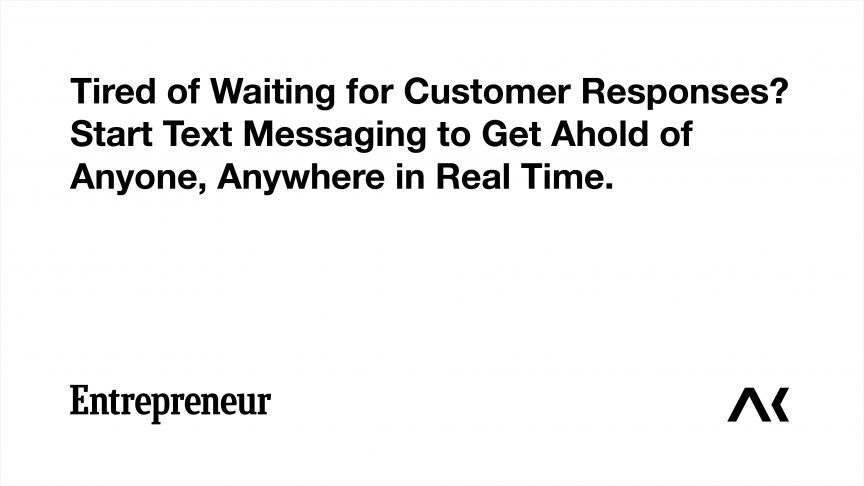This post originally appeared on Entrepreneur.com
The world is full of spam. Don’t let your business’s message be part of it.
We live in a world full of spam. Everywhere we go, brands are tracking and following us. Hence, we as consumers have become adept at ignoring ads, content and emails.
Related: The Sneaky Way SEO Spam Is Costing You Business — And How to Stop It
And, whether the outreach we receive comes in through emails, cold calls or other unsolicited communication channels from a business, our experience is one of a pervasive itch; and we find that the more we ignore that itch, the more the annoyance eases.
While customers and prospects are growing ever more irritated — and more adept at avoiding unwanted contact — the entrepreneurs on the other side of the communication channel are struggling to rise above the noise and be heard.
Are you one of those entrepreneurs struggling to reach your customers? Here’s what to do.
There is a better way. Start text messaging.
By using text-messaging software, your business and your team can more easily engage in real-time human-to-human conversations and reduce the spammy, sales-pitchy jargon that customers are all too familiar with.
With 98 percent read ratesand 40 percent response rates, according to MarketingProfs data, text messaging is increasingly how consumers prefer to communicate.
Today, 89 percent of people always have their smartphone within reach, and more than 5 billion people around the world are connected to a mobile device. It’s no wonder, then, that text messaging is becoming the way businesses new and old are getting real engagement with customers.
Related: Deliver content straight to the Inbox; How to Surpass the Spam Filter
Here are some best practices businesses should follow when text messaging customers to avoid being ignored or blocked:
Be careful about your initial text message engagement.
Considering that “outreach overload” is already prevalent, businesses certainly do not want customers’ text message inboxes filling up, either.
Texts are typically personal — they’re where communication with friends, family and co-workers intimately take place. To avoid spamming people, make sure first that a connection with a customer or prospect is established. Perhaps this person stopped by a booth at an industry conference, connected with you on social media or met you at a networking event. Whatever it was, make sure that the initial connection is there before you blast messages to a list procured from a database.
Build an authentic connection.
Business is all about relationships, and especially for emerging businesses, relationships are key to building strong relationships quickly and early.
In the same way that personal relationships need to be nurtured, customers need individualized time and attention to connect with a business. Teams reaching out to customers should take the time to get to know the individual — his or her preferences, desires, goals and interests — before asking for anything (“Buy this,” “Download that,” etc.).about:blank
This way, calls to action can be personalized — instead of sounding like they’re coming from a robot or automated system. Text messaging is a great way to build up this authenticity, as it reaches customers where they are (on their smartphones) and allows them to respond on their own terms.
Respond in real time.
We now live in an on-demand economy. Customers expect everything instantly, and via smartphone. Hailing a ride, ordering food or depositing checks are just a few of the countless ways consumers are getting used to their needs being met right away.
However, considering that just about anyone with a smartphone is using it not only to communicate but as an instant gratification device, it makes sense that text messaging is becoming a key way to reach just about any target market.
Just as businesses need to make their products and services available in real time, they also need to respond to requests, questions and feedback in the same way. Text messaging is a great way to achieve this since most consumers have their smartphones at their fingertips at any given moment.
Provide value.
Every interaction with a customer should be focused on delivering value. A business serves to help customers in all that they do, whether that be connecting them to a viable job opportunity, getting in touch with remote healthcare providers quickly or making sure lenders and lessees can communicate on contracts efficiently.
Bottom line: The more value that’s provided throughout the communication lifecycle, the more likely a prospect is to stay on the hook, build trust and become not just a customer, but an advocate. Again, text messaging is a great way to send touch points, but will only be effective if value is delivered. Too many “asks” run the risk of deterring a customer for good.
Text messaging is transforming the way business is done. From ignored, spammy messages to personalized, authentic conversations with a real human, text messaging is making it easier than ever for businesses to enable their teams to engage with their target market.
Related: The 7 Things You Need to Know to Text With Good Etiquette
In a world where customers expect value, connection and on-demand everything, text messaging is the way to satisfy these expectations. It may be the best channel for you, too.

